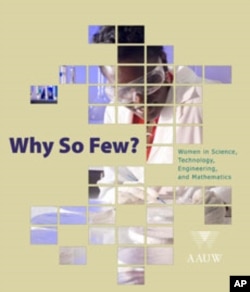Mae Jemison has accomplished many things in life. She is a chemical engineer, medical doctor, college professor, and in 1992, became the first African-American woman astronaut to blast into space.
New mission
Jemison now runs her own medical technology company, BioSentient Corporation. She's also a spokesperson for Bayer Corporation's science outreach program.
Each year since 1995, the company has commissioned a survey on science literacy and workplace issues. This year, it polled 1,200 women and minority chemists and chemical engineers. Careers in science, technology, engineering and math are collectively known as STEM.
"I think that survey shows that, as minorities and women pursue a STEM career, they have to face a number of barriers along the pipeline and what we need to do as a society is really understand what these roadblocks are," says Jemison.
While women and minorities make up two-thirds of the American workforce, they represent less than 25 percent of STEM careers. The survey cites poor schools, lack of quality science and math programs, persistent negative stereotypes, financial cost and school and workplace bias as the reasons why.
Early interest
Jemison says the survey also finds children are interested in science at an early age.
"That means is that kids come out of the chute excited about the world around them. They are interested in what is going on but hit roadblocks. They are really derailed from their track to becoming professional scientists by academic systems and societies that are neither color blind nor gender blind."
Nearly two-thirds of those polled said women and minorities in STEM careers are under-represented in their companies or institutions. Forty percent said they were discouraged from pursuing their chosen career, typically in college and often by their professors, an experience Jemison remembers from her undergraduate days.
She says her professors were less than enthusiastic to see her in class. "It ranged from looking at me when I would ask a question as though something was very strange and then some other student would ask the same question and the teacher would say, 'This is an astute observation.'"
Big gap
Despite a gradual increase in women graduating with undergraduate and graduate degrees in science fields, the gap between men and women remains significant in the U.S. workplace.
That's according to a second report released this week by the American Association of University Women. "Why So Few?" compiles academic research from the last 15 years. Its findings underscore the social and cultural bias and barriers in higher education reported by the chemists and engineers in the Bayer survey.
Co-author Andresse St. Rose says, for example, while girls earn high school math credits at the same rate as boys, the myth that girls aren't good at math is persistent and powerful.
"Because of that negative stereotype, girls are more likely to believe that they are less able in math compared to boys who have similar grades and tests scores in math," says St. Rose.
But she is hopeful the situation can be reversed. "We believe that people can reset their biases by taking a proactive step, choosing to educate themselves more about women in these fields, by putting up positive images of women in science in their classrooms and in their homes."
The AAUW report recommends steps to raise awareness about girls' achievement and interest in science, and to get colleges to attract and keep more female students and faculty. St. Rose says all sectors of the community must implement these initiatives in order for them to be successful including, "kindergarten through 12th grade teachers and guidance counselors, college and university administrators and certainly employers and policymakers."
Former astronaut Mae Jemison agrees. She says stronger science programs in schools and colleges will not only put more women and minorities in science fields, but also fuel a more literate democracy.




![Mae Jamison, former astronaut [left], promotes science literacy across the United States to produce more scientists and educate young people with a basic level of science and technology understanding.](https://gdb.voanews.com/fd861d65-1903-404d-b938-814f9cea30c1_w250_r1_s.jpg)



